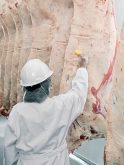In 2007, Alberta Beef Producers funded a transportation benchmarking study led by Dr. Karen Schwartzkopf-Genswein of Agriculture and Agri-Food Canada’s Lethbridge Research Station. The research team surveyed over 9,000 loads and close to half a million cattle commercially transported to, from and within Alberta over an 18-month period. That study was completed in 2009 and published in 2012 (e.g. J. Anim. Sci. 90:10:3606-3617). They reported that 99.98 per cent of short haul (four hours or less) and over 99.95 per cent of long haul (four hours or more) cattle arrived at their destination with no serious problems (e.g. lame, downer or dead). So on the whole, Canada’s cattle transportation sector is doing a very good job.
Read Also

Body condition, nutrition and vaccination for brood cows
One of the remarkable events of the past century related to ranching has been the genetic evolution of brood cows….
However, the study also found that some cattle were more likely to have problems than others. Yearlings and fat cattle coped with transport well. On average, problems were only found in one for every 4,407 yearlings and one for every 2,908 fat cattle. In contrast, one of every 1,773 weaned calves became lame, down or dead. In other words, calves were 1.5 times more likely to have problems than fat cattle, and 2.5 times more likely to have problems than yearlings. That indicates that Canada’s beef industry could improve animal welfare and save money by finding better ways to transport weaned calves.
So in 2010, the BCRC funded a followup study with this team to identify factors influencing transportation outcomes and health in weaned beef calves. The results of one of these projects was published last summer (J. Anim. Sci. 92:5142-5154).
What they did: 24 loads of 2,238 commercial beef calves were trucked from auction markets (18 loads) or ranches (six loads) to four feedlots during the fall run (two loads in September, 13 in October, five in November and four in December). Two loading densities were compared. Half of the loads used a loading density quite close to average industry practice identified in the ABP benchmarking study (0.67m2/calf or less). The other half allowed more space (more than 0.67m2/calf). Most trips were nearly eight hours long, though some lasted nearly 24 hours. Among many other things, animal health/condition was visually evaluated and animal weight and blood samples were collected before and after loading. Air temperature was recorded on the days before transportation, and air temperatures in the trailer were monitored throughout the trip. Auction mart calves were given an antibiotic on arrival, ranch-direct calves were not, and animal health treatments were tracked during the first 30 days on feed.
What they learned: All calves were reported to be in good condition at loading and when checked partway through the trip, although one calf was down and had to be euthanized when it arrived at the feedlot. Blood samples indicated that calves hauled at the higher loading density were slightly more dehydrated on arrival than calves that had more space during transport. Dehydration was also related to temperature changes. Calves became more dehydrated if temperatures during transport were much higher or lower than they were accustomed to. Shrink was higher for calves hauled in trailer temperatures below 5 C (3.93 per cent) than for calves hauled in trailers warmer than 5 C (2.77 per cent).
A total of 156 calves was pulled during the first month on feed. As expected, the majority of these (134/156) was pulled and treated for bovine respiratory disease. Treatment rates can’t be compared between the ranch-direct and auction mart-sourced calves, because they went to different feedlots and because the auction mart calves were treated with an antibiotic on arrival while the ranch-direct calves weren’t. However, temperature during transport affected treatment rates. Treatment rates were 2.5 to 8.5 times higher for calves hauled when the trailers were colder than 5 C than for calves hauled in trailers warmer than 5 C.
When the farm records were checked, it turned out that the downer calf that was euthanized on arrival at the feedlot had been sick and treated with antibiotics shortly before being loaded. Although it appeared to be fine when it was loaded, it ended up in a high-density load, travelled in cold weather, went down and ended up dead. While one example does not make a rule, this anecdote is a pretty clear example of why pre-transport decision-making is important. Sick and injured (compromised) animals cannot cope with the stresses of transport as well as healthy animals.
Do not load sick or injured animals, if you can avoid it. But when transportation is necessary, compromised livestock should be transported with special provisions. These can include segregating the animal(s), providing them with more space and bedding, loading them last and unloading them first.
The Beef Research Cluster is funded by the National Checkoff and Agriculture and Agri-Food Canada with additional contributions from provincial beef industry groups and governments to advance research and technology transfer supporting the Canadian beef industry’s vision to be recognized as a preferred supplier of healthy, high-quality beef, cattle and genetics.

















